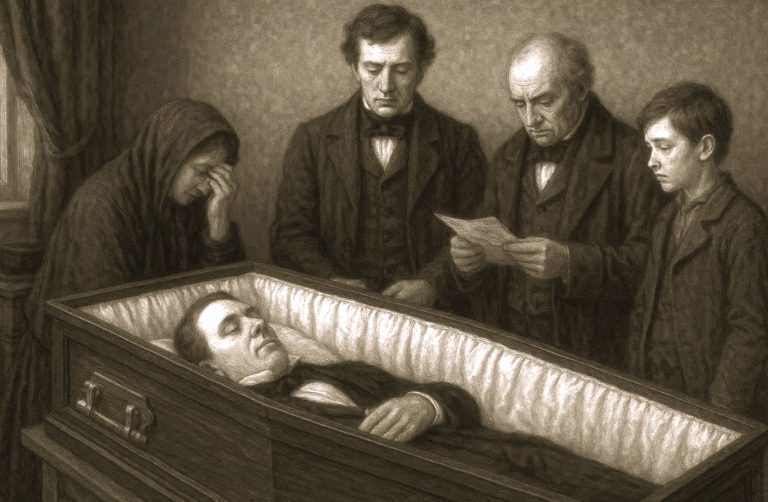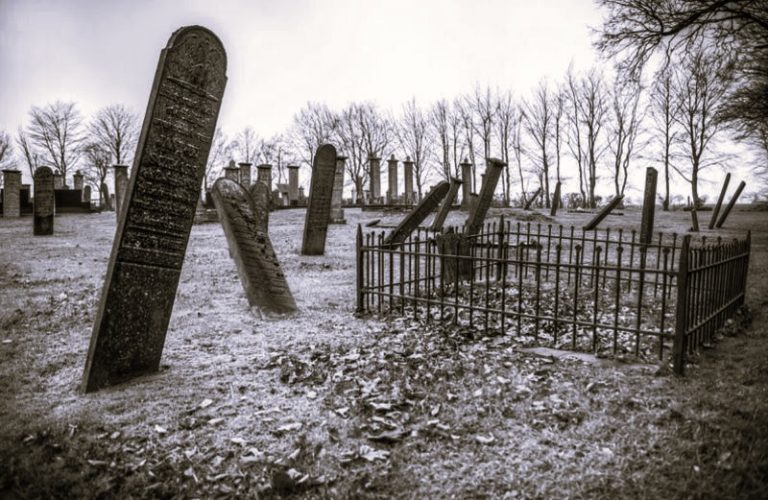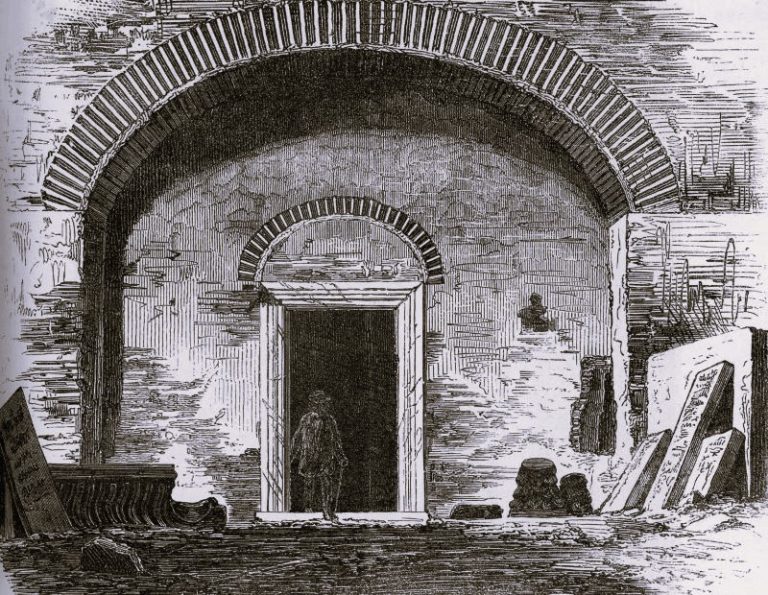
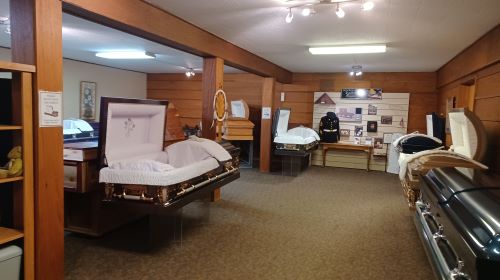
This evolving landscape reflects society’s changing relationship to death.

By Matthew A. McIntosh
Public Historian
Brewminate
Introduction
For centuries, death care — the broad network of services and rituals surrounding the end of life — remained largely unaltered. Traditional funerals, embalming, and cemetery burials formed a predictable structure, culturally and commercially entrenched. But in recent years, seismic shifts in societal values, environmental awareness, technological innovation, and economic pressures have begun to transform how we approach death, grieve, and memorialize our dead.
What was once a conservative and slow-moving industry is rapidly evolving. The death care industry — encompassing funeral homes, crematoriums, cemeteries, grief counseling, estate planning, and increasingly, digital and ecological services — is undergoing a renaissance driven by changing demographics, values, and technologies. Here’s how.
Cultural Shifts: From Taboo to Transparency
Historically, death has been a subject veiled in euphemism and ritual — largely removed from everyday conversation. But millennials and Gen Z, who are now increasingly responsible for making end-of-life decisions for aging parents or even peers, are breaking taboos. Death positivity movements, led by voices like Caitlin Doughty (founder of The Order of the Good Death), are advocating for more honest and informed discussions about death.
This cultural shift is reframing how people plan funerals, memorials, and even what constitutes a “good death.” Instead of stoic church ceremonies and stiff wakes, we now see celebration-of-life parties, home funerals, and personalized memorials that reflect the unique identity of the deceased.
Technology and Digital Legacy
Virtual Funerals
Virtual funerals have emerged as a significant innovation in the death care industry, especially accelerated by the COVID-19 pandemic, which forced families to find alternative ways to gather and mourn. These online services, typically hosted via platforms like Zoom or YouTube, allow friends and relatives from around the world to participate in real-time memorials, offering readings, sharing memories, or simply observing rituals from the safety of their homes. Beyond necessity, virtual funerals have proven to be inclusive, cost-effective, and flexible, helping those with financial or physical limitations still feel present and connected. Many funeral homes now offer hybrid models, combining in-person elements with livestreaming and digital guest books, making virtual attendance a permanent and valued part of modern memorial practices.
Digital Memorials

Digital memorials are transforming how we remember and honor the dead, offering enduring spaces online where memories, photos, stories, and tributes can be shared and preserved. Websites like ForeverMissed, Keeper, and GatheringUs allow families and friends to create interactive memorial pages that serve as living archives, accessible anytime from anywhere in the world. These platforms often include features like virtual candles, audio recordings, comment threads, and even timeline-based life stories, allowing for dynamic storytelling and communal grieving. As people increasingly live much of their lives online, digital memorials bridge the gap between physical absence and virtual presence, making memory more accessible, collaborative, and permanent.
End-of-Life Planning Tools
End-of-life planning tools have become an essential part of modern death care, empowering individuals to make informed, personalized decisions about their legacy and easing the burden on loved ones. Digital platforms like Cake, Everplans, and Farewelling provide comprehensive services that help users organize wills, healthcare directives, funeral preferences, financial documents, and even personal messages to be delivered after death. These tools often offer step-by-step guidance and secure cloud-based storage, allowing for updates as circumstances change. By normalizing proactive planning and putting control in the hands of the individual, these platforms reflect a broader cultural shift toward transparency, autonomy, and preparedness in facing death.
The Rise of Green and Alternative Burials
Overview
Environmental concerns are rapidly reshaping burial practices. The traditional American burial — involving embalming fluids, hardwood caskets, and concrete vaults — is not only expensive but ecologically harmful. In response, consumers are seeking greener alternatives.
Natural (Green) Burials
Natural, or green, burials are an increasingly popular alternative to conventional interment, driven by a growing desire for environmentally conscious death care. Unlike traditional burials, which often involve embalming fluids, metal caskets, and concrete vaults, natural burials forgo chemical preservation and use biodegradable materials like simple pine boxes or cloth shrouds, allowing the body to decompose naturally and return to the earth. These burials often take place in designated green cemeteries or conservation burial grounds that double as protected natural spaces, promoting ecological restoration and biodiversity. Advocates view green burial not only as a sustainable option but as a spiritually resonant return to the cycle of life, offering a final act of environmental stewardship.
Aquamation (Alkaline Hydrolysis)
Aquamation, also known as alkaline hydrolysis or water cremation, is a growing eco-friendly alternative to traditional cremation and burial. The process uses a solution of water and potassium or sodium hydroxide, combined with heat and gentle agitation, to accelerate the natural decomposition of the body, reducing it to bone ash and a sterile liquid byproduct. Unlike flame cremation, aquamation produces no harmful emissions, uses significantly less energy, and retains more of the body’s mineral content in the ashes. Legal in an increasing number of U.S. states and other countries, aquamation is being embraced by environmentally conscious individuals seeking a gentler, more sustainable method of disposition. Its growing popularity reflects a broader trend toward green death care and a reimagining of how we return to the earth.
Human Composting (Natural Organic Reduction)
Human composting, officially known as Natural Organic Reduction (NOR), is an innovative and eco-conscious method of body disposition that transforms human remains into nutrient-rich soil through controlled decomposition. In this process, the body is placed in a reusable vessel filled with organic materials like wood chips, alfalfa, and straw, where it breaks down naturally over the course of several weeks with the help of heat, moisture, and microbial activity. The resulting soil—approximately one cubic yard—can be returned to families or used to nourish conservation land. Legalized in several U.S. states including Washington, Oregon, and California, human composting offers a deeply ecological and symbolic alternative to traditional burial or cremation, appealing to those who want their death to actively contribute to the health of the planet.
Mushroom Suits and Bio-Urns
Mushroom suits and bio-urns represent some of the most imaginative and environmentally thoughtful innovations in green death care. The mushroom burial suit, such as the Infinity Burial Suit, is infused with specially cultivated mycelium designed to decompose the body efficiently while neutralizing toxins and enriching the surrounding soil. Bio-urns, on the other hand, combine cremated remains with seeds or saplings to grow trees, transforming ashes into living memorials. Both options reflect a profound shift in how we view death—not as an end, but as a regenerative process that contributes to new life. These alternatives are especially appealing to those who wish to reduce their ecological footprint and leave behind a living legacy rooted in sustainability and renewal.
Cremation and Its Dominance
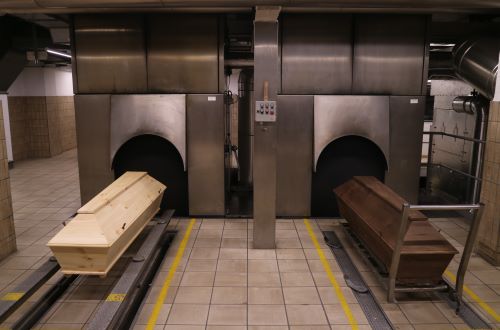
Cremation has overtaken traditional burial in many parts of the world, particularly in North America, where cremation now accounts for over 60% of all body dispositions — a rate expected to climb to 80% by 2040.
Cremation is:
- More affordable (typically 30–60% cheaper than burial),
- Seen as more environmentally conscious (though this is debated), and
- Less restrictive (ashes can be scattered, kept, or incorporated into keepsakes).
Cremated remains are now being turned into diamonds, fireworks, vinyl records, ocean reefs, and even tattoos — expanding the boundaries of personal legacy.
The Business of Death: New Models and Disruptors
The traditional funeral home model — family-owned, highly ritualized, and opaque in pricing — is giving way to streamlined, digital-first services
Direct cremation companies are reshaping the funeral industry by offering simple, affordable, and no-frills alternatives to traditional end-of-life services. Unlike conventional funerals, direct cremation involves the immediate cremation of the body without a formal viewing, visitation, or ceremony, allowing families to hold memorials on their own terms. Companies like Tulip, Simplicity, and Solace streamline the process through user-friendly websites, flat-rate pricing, and door-to-door service, often making arrangements entirely online or by phone. This approach appeals especially to cost-conscious consumers and those seeking greater control and flexibility, reflecting a broader shift toward personalized and minimalist death care that prioritizes practicality and transparency over ritual and expense.
Subscription-based preplanning for funerals is an emerging model that allows individuals to prepare and pay for their end-of-life arrangements over time through manageable monthly payments. This approach, offered by companies like Tomorrow and MemorialPlanning.com, provides financial predictability while giving users the peace of mind that their wishes—whether cremation, burial, or other services—are clearly documented and funded. Unlike traditional lump-sum prepayment plans, these subscriptions often include added features such as legal document storage, will creation, and periodic plan reviews to reflect changing preferences or life circumstances. This model resonates with younger generations and budget-conscious consumers who value flexibility, transparency, and autonomy in managing their final affairs.
Corporate consolidation has become a defining trend in the death care industry, with large publicly traded companies acquiring numerous small, family-owned funeral homes, cemeteries, and crematoriums across the country. Service Corporation International (SCI), one of the largest players, now operates thousands of locations under various local names, standardizing operations and leveraging economies of scale to dominate the market. While consolidation can bring improved efficiency and access to capital, critics argue it may also reduce personalized service, limit consumer choice, and prioritize profit over compassion. This tension between corporate scale and local tradition reflects the broader challenges facing an industry balancing modernization with the deeply personal nature of death care.
Yet there’s also a strong counter-trend: boutique funeral homes and death doulas offering highly personalized, transparent, and holistic end-of-life care.
Death Doulas and Emotional Reframing
Just as birth doulas support new life, death doulas guide individuals and families through the dying process. These professionals offer emotional, spiritual, and logistical support in the final days or weeks, helping reframe death as a natural and meaningful part of life.
They may assist with:
- Vigil planning and legacy projects,
- Navigating hospice and palliative care,
- Creating rituals or memory-making experiences.
This approach resonates with those seeking a more intimate and human death experience — one not confined to hospitals or funeral parlors.
Economic Pressures and the Push for Affordability
The average cost of a funeral with burial in the U.S. is now over $8,000 — a steep burden for many families. Inflation, wage stagnation, and rising healthcare costs have made even basic services feel out of reach.
Direct cremation and low-cost providers have gained significant traction as families seek more affordable and straightforward alternatives to traditional funeral services. By eliminating costly elements such as embalming, elaborate caskets, and formal ceremonies, direct cremation offers a respectful yet budget-friendly option that can often be arranged quickly and with minimal hassle. Low-cost providers specialize in transparent pricing and streamlined services, frequently offering online arrangements and flat fees that reduce the financial and emotional burden on grieving families. This growing segment reflects a shift toward practicality and accessibility in death care, ensuring that dignity in death is not limited by cost.
Funeral crowdfunding has become an increasingly common way for families and communities to cope with the often unexpected and substantial costs associated with death care. Platforms like GoFundMe enable friends, relatives, and even strangers to contribute financially toward funeral expenses, cremation fees, memorial services, and related costs. This grassroots approach not only helps alleviate the financial strain on grieving families but also fosters a sense of collective support and solidarity during difficult times. However, reliance on crowdfunding also highlights broader issues of funeral affordability and the gaps in social safety nets, prompting ongoing conversations about how society can better support end-of-life expenses for all.
State-funded indigent burial programs play a crucial role in ensuring that individuals who die without financial means or identifiable next of kin receive a dignified final disposition. These programs, often administered by local health departments or social services agencies, provide basic burial or cremation services at public expense, typically including a simple coffin or urn and a modest gravesite or cremation process. While the level of care varies by jurisdiction, these initiatives reflect a societal commitment to respecting the dead regardless of their economic or social status. However, funding limitations and varying policies can result in minimal ceremonies, highlighting ongoing challenges in addressing the needs of society’s most vulnerable populations in death care.
Legal and Ethical Changes
As laws around death care evolve, so do the possibilities.
- More U.S. states are legalizing human composting, water cremation, and home burials.
- Some municipalities are revisiting restrictive cemetery zoning laws.
- Digital legacy laws are being updated to ensure people can manage or bequeath social media and cloud accounts posthumously.
- Ethical questions are surfacing around AI memorials, body donation, and surveillance of grief data by tech companies.
This evolving legal landscape reflects — and sometimes struggles to keep up with — society’s changing relationship to death.
Conclusion: A More Personal, Purposeful, and Eco-Conscious Death
The death care industry is no longer a monolith. It is being democratized, decentralized, and diversified. The modern death experience is increasingly tailored, affordable, eco-conscious, and even, paradoxically, more alive — centered on meaning, connection, and legacy rather than uniformity and tradition.
As we face a future with longer lives, climate change, and new ethical frontiers in AI and biotechnology, our attitudes toward death will continue to evolve. And with them, so too will the rituals and industries that shape our final chapter. In the end, this transformation is not just about how we die — but about how we choose to live, and be remembered.
Originally published by Brewminate, 06.20.2025, under the terms of a Creative Commons Attribution-NonCommercial-NoDerivatives 4.0 International license.
